货币金融学课件-第五章-经济运行中的金融市场
- 格式:ppt
- 大小:1.27 MB
- 文档页数:44

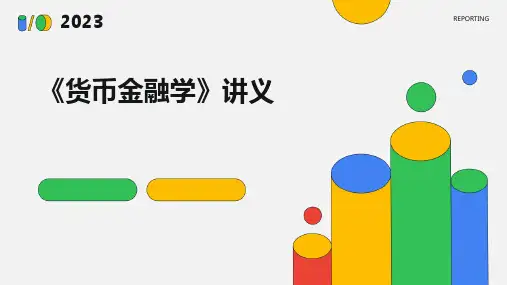

殷孟波《货币金融学》课件•货币与货币制度•信用与金融市场•金融机构体系与监管•货币政策理论与实践•国际金融与汇率制度•金融创新与金融科技发展01货币与货币制度货币起源与形态演变货币起源货币形态演变货币职能与作用货币职能货币作用货币制度及其演变货币制度货币制度演变货币制度经历了银本位制、金银复本位制、金本位制和纸币本位制等演变过程。
当代货币层次划分当代货币层次划分当代货币层次主要划分为M0、M1、M2等层次,其中M0指流通中的现金,M1指狭义货币(包括现金和活期存款),M2指广义货币(包括现金、活期存款和定期存款等)。
货币层次的意义货币层次的划分有助于中央银行进行宏观调控,通过控制不同层次的货币供应量来调节经济。
02信用与金融市场信用概述及形式信用形式信用定义包括商业信用、银行信用、国家信用、消费信用、民间信用等多种形式,每种形式都有其特定的应用场景和风险特点。
信用评级金融市场分类与功能金融市场分类根据交易对象、交易方式、交易期限等标准,金融市场可分为货币市场、资本市场、外汇市场、黄金市场等。
金融市场功能金融市场具有融资、投资、风险管理、价格发现等功能,对于促进经济发展和维护金融稳定具有重要作用。
金融市场参与者包括金融机构、企业、个人投资者、政府等,各类参与者在市场中扮演着不同的角色。
利率结构包括利率的期限结构、风险结构和利率的利差结构,反映了不同期限、风险和利差条件下的利率水平。
利率决定因素利率水平受多种因素影响,包括货币政策、通货膨胀率、国际收支状况、经济发展水平等。
利率市场化指利率水平由市场供求关系决定,政府或中央银行通过货币政策工具对利率进行调控和引导。
利率决定与结构分析金融工具创新与风险管理金融工具创新风险管理金融监管03金融机构体系与监管金融机构体系概述金融机构定义与分类01金融机构体系构成02金融机构体系功能03商业银行主要业务商业银行风险管理商业银行内部控制030201商业银行主要业务及风险管理非银行金融机构类型及功能非银行金融机构类型非银行金融机构功能非银行金融机构与商业银行的合作关系金融监管目标与原则金融监管目标金融监管原则金融监管手段与措施金融监管国际合作与协调04货币政策理论与实践货币政策目标设定及工具选择货币政策最终目标中间目标货币政策工具货币政策传导机制分析货币渠道通过改变货币供应量和利率水平,影响总需求和宏观经济运行信贷渠道通过银行贷款和资产负债表渠道,影响企业和个人的融资条件和投资消费决策汇率渠道通过改变汇率水平,影响国际收支和国内经济货币政策效果评估及挑战评估指标评估方法面临的挑战当代主要货币政策实践美国货币政策欧洲央行货币政策中国货币政策05国际金融与汇率制度国际收支平衡表编制及分析国际收支平衡表的概念编制原则和方法分析意义1 2 3汇率决定理论影响汇率的因素汇率变动的影响汇率决定因素及影响分析国际储备管理策略探讨国际储备的构成管理策略风险管理国际金融市场发展趋势国际金融市场的形成和发展01发展趋势02对中国的影响及应对策略0306金融创新与金融科技发展金融创新类型及影响分析金融创新类型影响分析金融科技发展现状及趋势预测发展现状趋势预测互联网金融模式探讨互联网金融模式包括P2P网贷、众筹、第三方支付等。
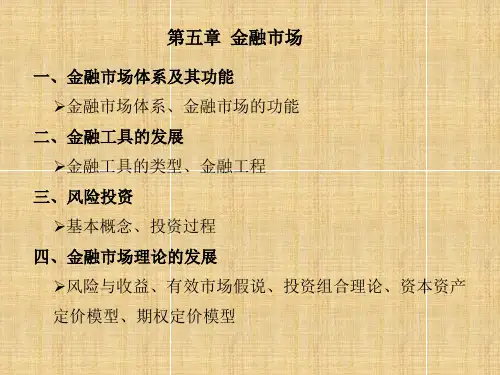
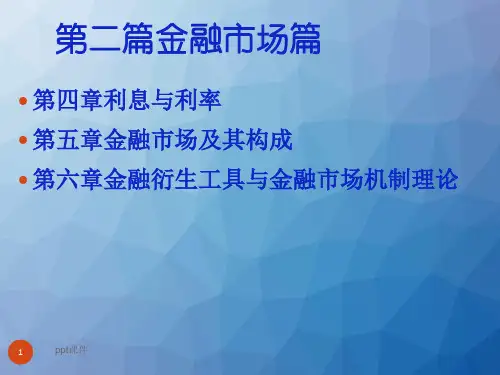

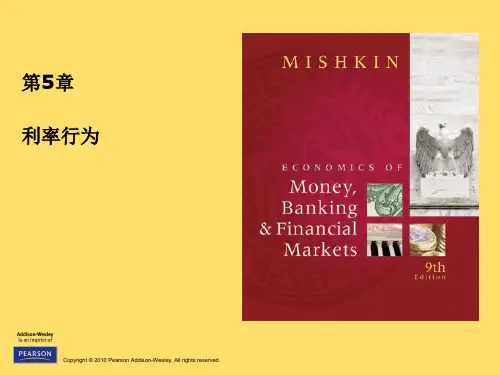
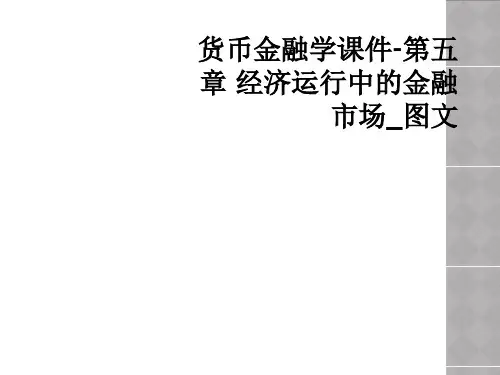


FinanceChapter2 Financial MarketsInterest Rates and Calculation of Interest RatesThe Behavior of Interest RatesThe Risk and Term Structure of Interest RatesThe Stock Market, theTheory of Rational Expectations, and the Efficient Market HypothesisLecture 5The Behavior of Interest Rates•Determinants of Asset Demand•Supply and Demand in the Bond Market •Supply And Demand in the Money Market: The Liquidity Preference FrameworkLearning ObjectivesIdentify the factors that affect the demand for assets.Draw the demand and supply curves for the bond market and the money market, identify the equilibrium interest rate.List and describe the factors that affect the equilibrium interest rate in the bond market and the money market.Identify and illustrate the effects on the interest rate of changes in money growth over time.Interest Rate Determination Theory•Asset Demand Theory•Bond Supply and Demand Analysis •Money Supply and Demand Analysis ——(Liquidity Preference Framework)Part 1Determinants of Asset Demand1.1 Determinants of Asset DemandAsset is a piece of property that is a store of value.资产就是具有价值储藏功能的财产Money, bonds, stocks, art, land, houses, farm equipment, and manufacturing machinery are all assets.1.1 Determinants of Asset DemandDeterminants of Asset Demand:•Wealth: total resources owned by the individual, including all assets;•Expected return relative to other assets; (Expected return: the return expected over the next period)•Risk relative to other assets; (Risk: the degree of uncertainty associated with the return)•Liquidity relative to other assets; (Liquidity: the ease and speed with which an asset can be turned into cash)1.2 Theory of Portfolio ChoicePart 2Supply and Demand in the Bond Market2 Supply and Demand in the Bond Market2.1 Demand CurveConsider the demand for one-year discount bonds, which make no coupon payments but pay the owner the $1,000 face value in a year.If the holding period = years to maturity = 1 year, rate of return = interest rateii=RR=FF−PP PPwhere i= interest rate = yield to maturityRR= rate of returnF = face value of the discount bondP = initial purchase price of the discount bond2.1 Demand CurveIf the bond sells for $950, the interest rate and rate of return areii=RR=$1000−$950$950=0.053=5.3%At a price of $900, the interest rate and rate of return areii=RR=$1000−$900$900=0.111=11.1%Each bond price has a corresponding interest rate and expected rate of return2.1 Demand CurveAs predicted by portfolio theory, when the rate of return is higher, with all other economic variables (such as income, expected returns on other assets, risk, and liquidity) held constant, the quantity demanded of these bonds will be higher.根据资产需求的决定因素,当回报率上升时,其他要素不变,资产需求量也随之上升。
